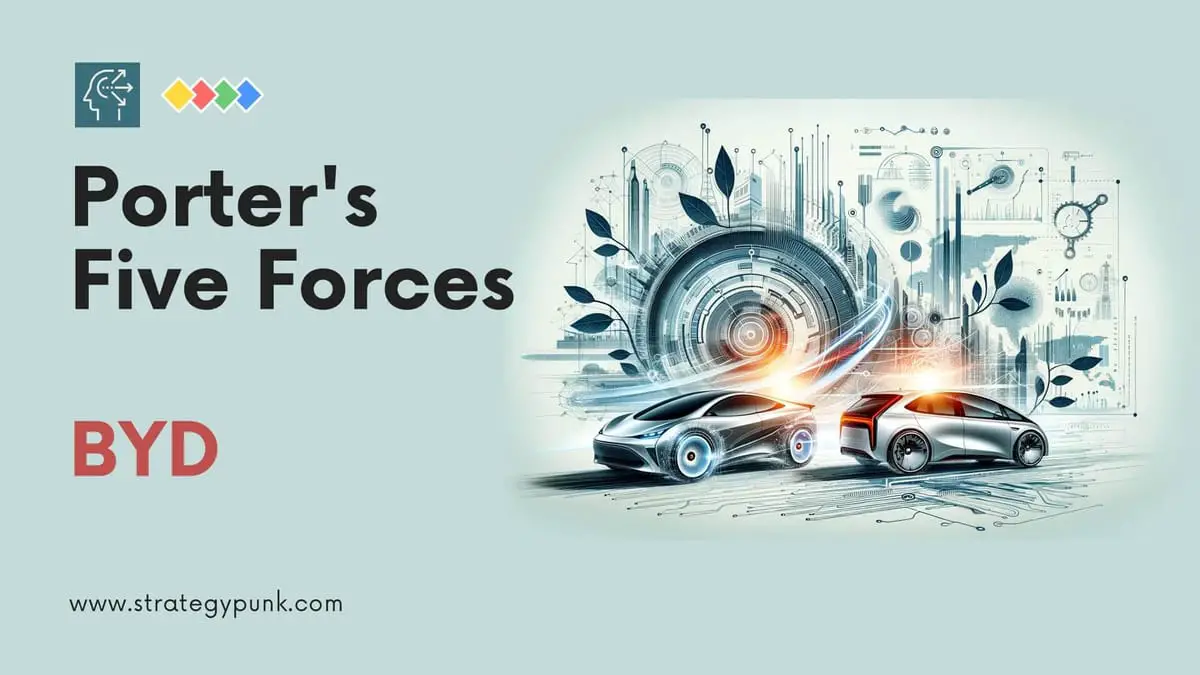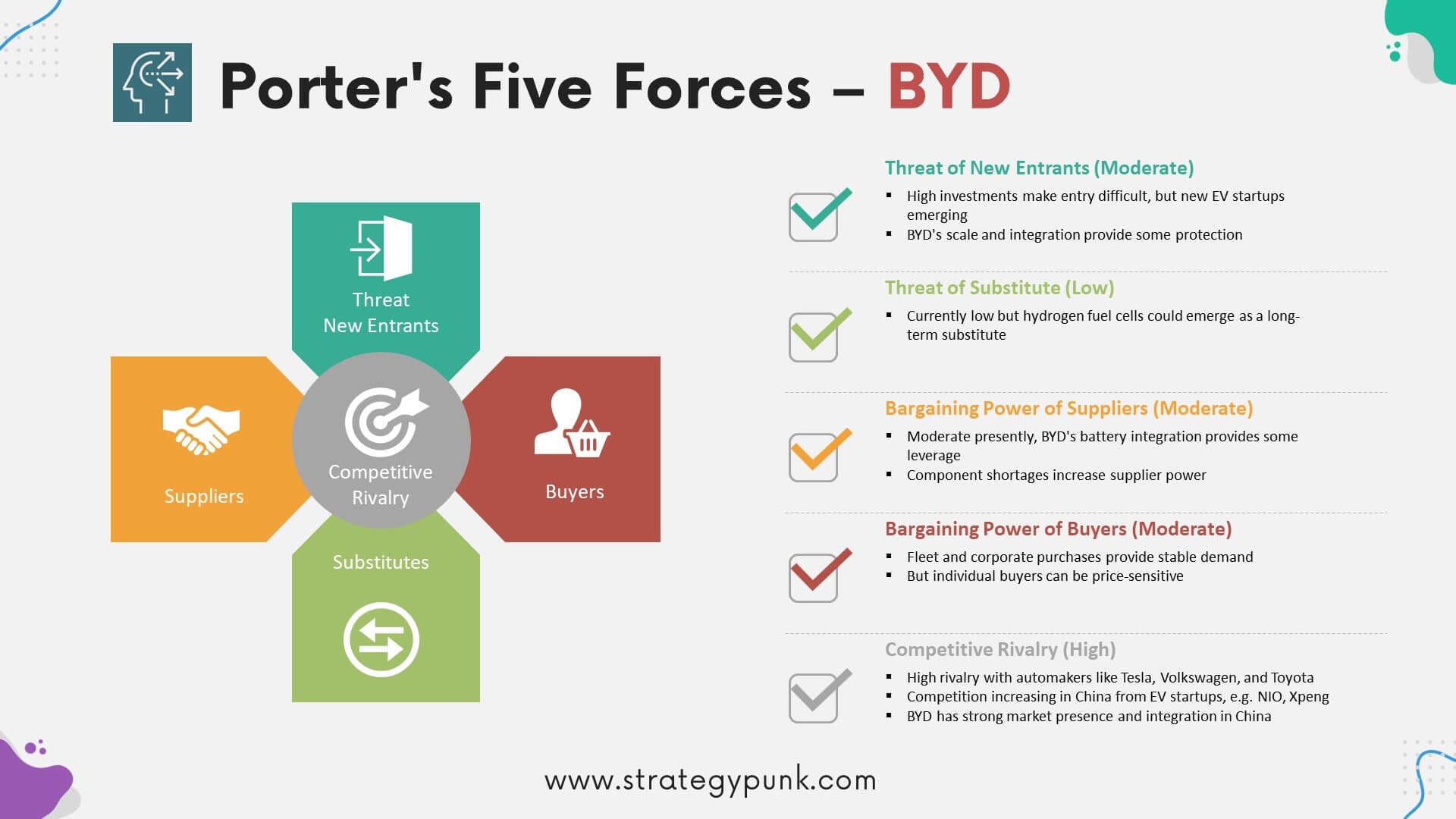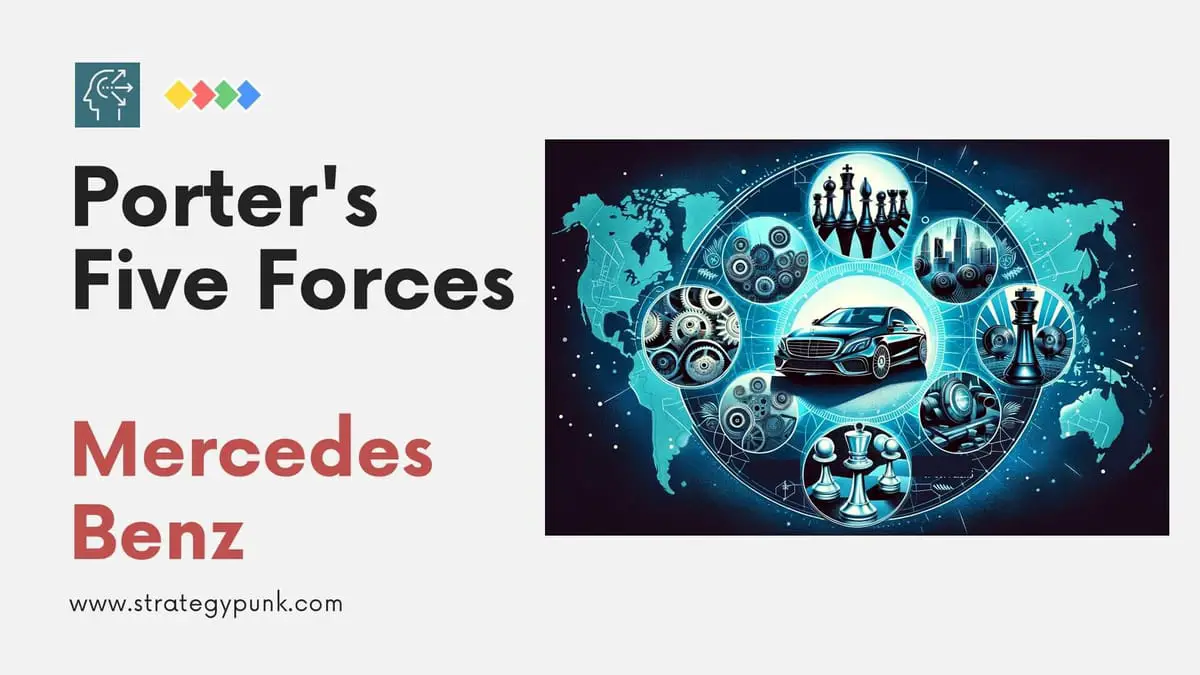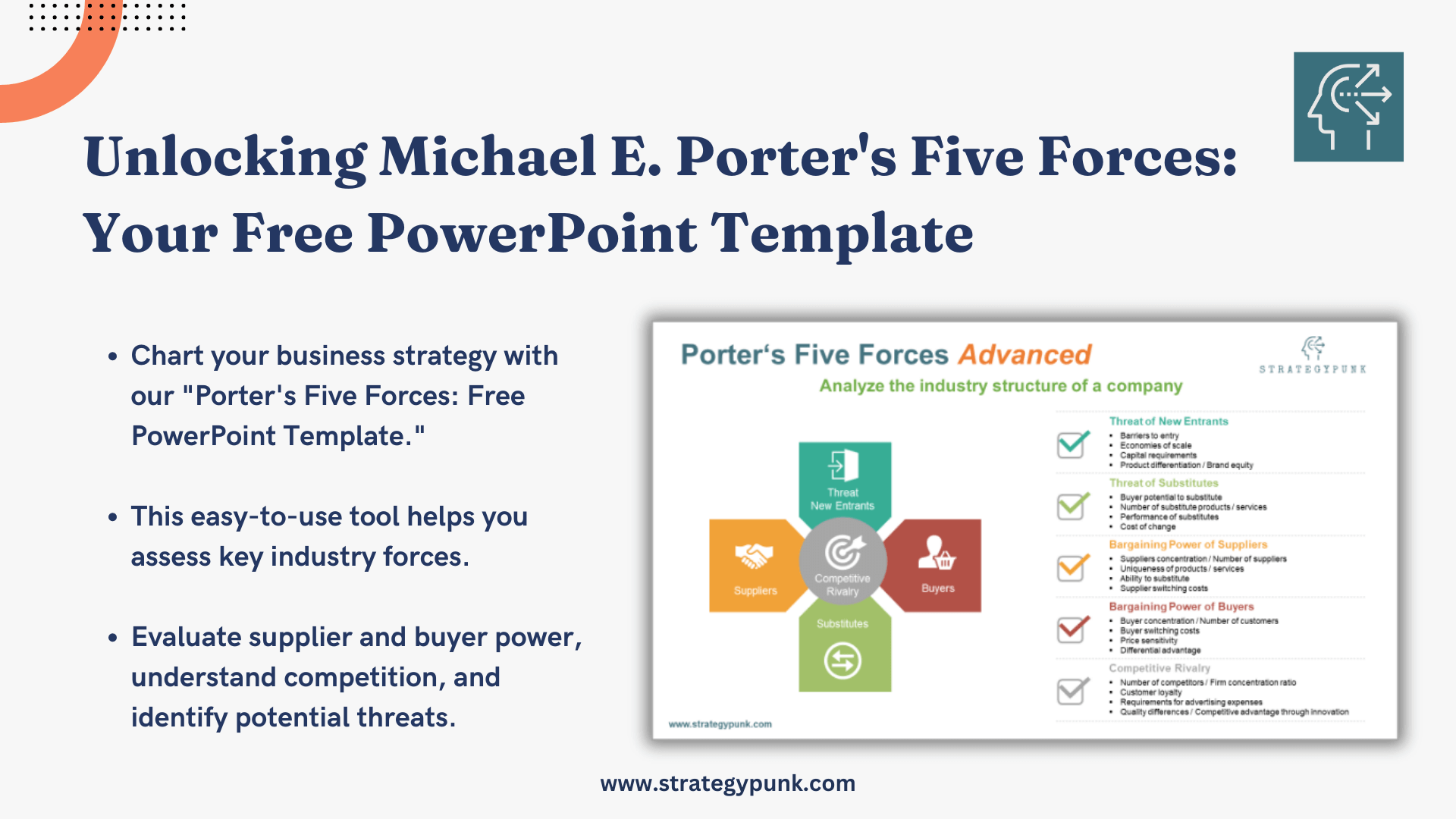Porter's 5 Forces Analysis for BYD: Free PPT Template and In-Depth Insights 2024
Download our free PowerPoint template for Porter's 5 Forces Analysis specifically designed for BYD. Gain in-depth insights into the competitive landscape with our 2024 guide. Essential for strategists and analysts.

Introduction Porter's 5 Forces for BYD
BYD (Build Your Dreams) is a leading Chinese manufacturer of electric vehicles, batteries, electronics, and rail transit.
Founded in 1995 as a battery company, BYD has grown into a global conglomerate with over 200,000 employees. Understanding the competitive landscape is vital for BYD's continued success as the world transitions to electric vehicles.
We will analyze BYD using Porter's Five Forces, a framework for analyzing competition developed by Harvard Business School professor Michael Porter.
Additionally, we provide a free and fully editable PowerPoint and PDF template for a more detailed exploration of this analysis.
Background of BYD
BYD was founded in 1995 in Shenzhen, China by Wang Chuanfu. Beginning as a rechargeable battery manufacturer, BYD expanded into the automotive industry in 2003.
BYD is the largest electric vehicle manufacturer globally, selling over 680,000 electric vehicles in 2021. Other BYD business segments include electronics, batteries, solar panels, LEDs, energy storage systems, monorails, skyrails, and forklifts.
BYD invests heavily in R&D, with over 30,000 engineers, and its total R&D investment exceeds $800 million annually.
BYD Porter's Five Forces (Plus FREE PPT)

Competitive Rivalry: High
The electric vehicle industry has high competitive rivalry. BYD competes with automakers like Tesla, Volkswagen, and Toyota and established Chinese brands like SAIC and Geely.
The high growth potential of EVs is attracting both traditional automakers and new entrants. However, BYD benefits from economies of scale and a robust domestic market presence.
Main points:
- High rivalry with automakers like Tesla, Volkswagen, and Toyota
- Competition increasing in China from EV startups, e.g. NIO, Xpeng
- BYD has strong market presence and integration in China
Threat of New Entrants: Moderate
The threat of new entrants is moderate. High capital investments in manufacturing and R&D make entry difficult.
However, EV startups like Nio, Xpeng, and Li Auto have emerged in recent years. BYD's scale and vertical integration provide some protection.
Main points:
- High investments make entry difficult, but new EV startups are emerging
- BYD's scale and integration provide some protection
Threat of Substitutes: Low
The threat of substitutes is currently low. Electric vehicles are replacing ICE vehicles rapidly due to the total cost of ownership and government emission regulations.
However, long-term hydrogen fuel cell vehicles could emerge as substitutes if refueling infrastructure improves.
Main points:
- Currently low but hydrogen fuel cells could emerge as a long-term substitute
Bargaining Power of Suppliers: Moderate
BYD has moderate bargaining power over its suppliers. Its vertical integration into batteries gives it leverage.
However, many standard components like semiconductors have shortages, giving suppliers more leverage.
Main points:
- Moderate presently, BYD's battery integration provides some leverage
- Component shortages increase supplier power
Bargaining Power of Buyers: Moderate
Buyers have moderate bargaining power. BYD sells to both commercial and retail consumers.
Government and corporate fleet purchases provide stable demand. However, individual buyers can be price-sensitive, especially as competition increases.
Main points:
- Fleet and corporate purchases provide stable demand
- But individual buyers can be price-sensitive
Strategies for Success
For continued success, BYD should pursue these strategies:
- Maintain technology leadership in batteries to support electric vehicle range and performance
- Establish sales and service networks in export markets like Europe, South America, and Southeast Asia
- Develop innovative EV models tailored to the demands of international markets
- Forge additional overseas partnerships to share technology and reduce risk
- Vertically integrate component manufacturing to control costs and supply
Conclusion
Using Porter's Five Forces analysis, we determined the electric vehicle industry has high competitive rivalry but offers strong growth potential for established players like BYD.
BYD is positioned well with its market leadership in China, vertical integration, and heavy R&D spending on next-generation EV technology.
Frequently Asked Questions
What are BYD's competitive advantages in electric vehicles?
BYD has developed significant competitive advantages from its vertical integration, massive scale, access to China's supply chains, and engineering talent.
Additional advantages come from BYD's industry-leading R&D and innovations in battery technology.
What is BYD's overseas expansion strategy for electric vehicles?
BYD is pursuing a gradual overseas expansion strategy by reducing risk through joint ventures, sales partnerships, and contract manufacturing agreements.
BYD is tailoring EV models like the Atto 3 and Seal specifically to the demands of export markets in Europe, Southeast Asia, Africa, and South America.
Who are BYD's major competitors in electric vehicles?
BYD's major competitors globally include Tesla, Volkswagen, Toyota, and Chinese companies like SAIC and Geely.
Domestically in China, BYD competes with EV startups Nio, Xpeng, and Li Auto. As more automakers launch EV models, competition will intensify.
What innovations is BYD making in batteries and EV technology?
BYD innovates in cell-to-pack technology, blade batteries, LFP battery chemistry, supercharging times, vehicle platforms, and integrated vehicle controls.
These aim to improve EV range, safety, performance, and cost.
Using Porter's Five Forces framework, I hope this analysis provides insightful perspectives on BYD's competitive position in the fast-growing global electric vehicle industry.
How has the degree of rivalry among competitors in the automobile industry changed over time?
In the 1970s-1980s, foreign competitors entered the US auto market, leading to increased rivalry and intense price competition as firms competed for market share. This marked a shift from the previous dominance of domestic automakers.
In the 1990s, the rivalry intensified further due to a flood of new vehicle models and concepts. Firms began competing aggressively on differentiation through design, brand image, and engineering quality.
The early 2000s saw fierce competition, with significant mergers and acquisitions leading to greater industry concentration among the top firms. However, the number of major global competitors remains moderate.
In recent years, the rivalry has been amplified by the rise of electric vehicles and autonomous driving technologies. Major tech companies like Apple, Google, Tesla and startups are disrupting the status quo.
Rivalry today centers around innovation, digitalization, customer experience, and new mobility business models alongside traditional competition. Leading automakers invest heavily in electrification, connectivity, and autonomous driving.
Porter's 5 Forces Analysis for BYD PowerPoint Template
free and fully editable PPT template
BYD Porter's 5 Forces Analysis PowerPoint Template
BYD Porter's 5 Forces Analysis PDF Template
Discover more
Clickworthy Resources
BYD SWOT Analysis: Free PPT Template and In-Depth Insights 2024
Download the free BYD SWOT Analysis PowerPoint Template 2024. Get in-depth insights into BYD's strengths, weaknesses, opportunities, and threats. Ideal for strategic planning and market analysis.

Porter's 5 Forces Analysis for Mercedes Benz: Free PPT Template 2024
Explore our in-depth 2024 analysis of Mercedes-Benz using Porter's 5 Forces. Gain strategic insights with our free PowerPoint template on luxury auto trends, competitive dynamics, and market strategies.

Unlocking Michael E. Porter's Five Forces: Your Free PowerPoint Template
Chart your business strategy with our Porter's Five Forces: Free PowerPoint Template. This easy-to-use tool helps you assess fundamental industry forces. Evaluate supplier and buyer power, understand competition, and identify potential threats.

Porter's 5 Forces Analysis for Netflix: Free Templates and In-Depth Insights 2024
Get a comprehensive Porter's Five Forces Analysis of Netflix with a free PowerPoint template for 2024. Understand Netflix's competitive dynamics and strategies in the streaming industry.







